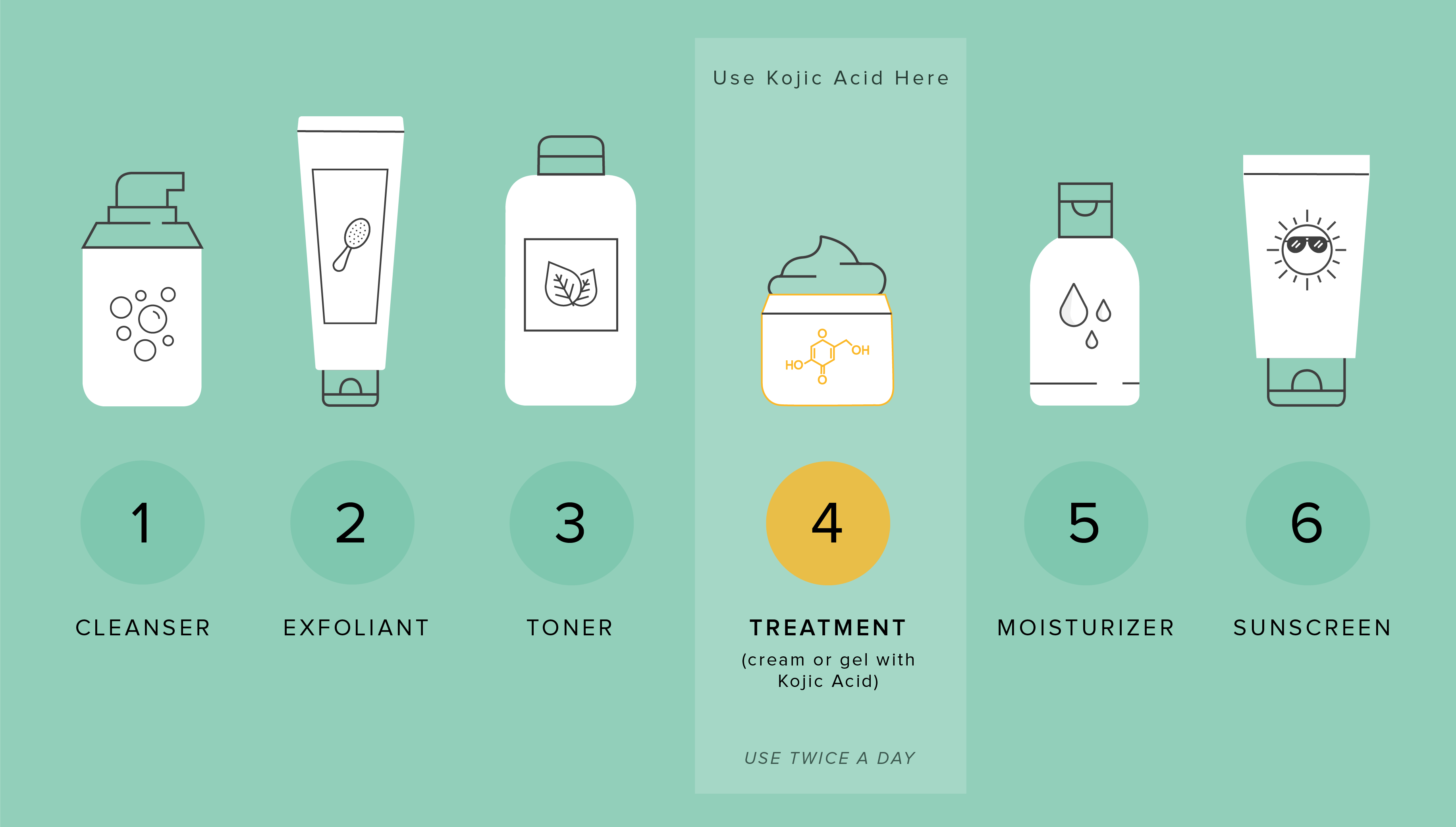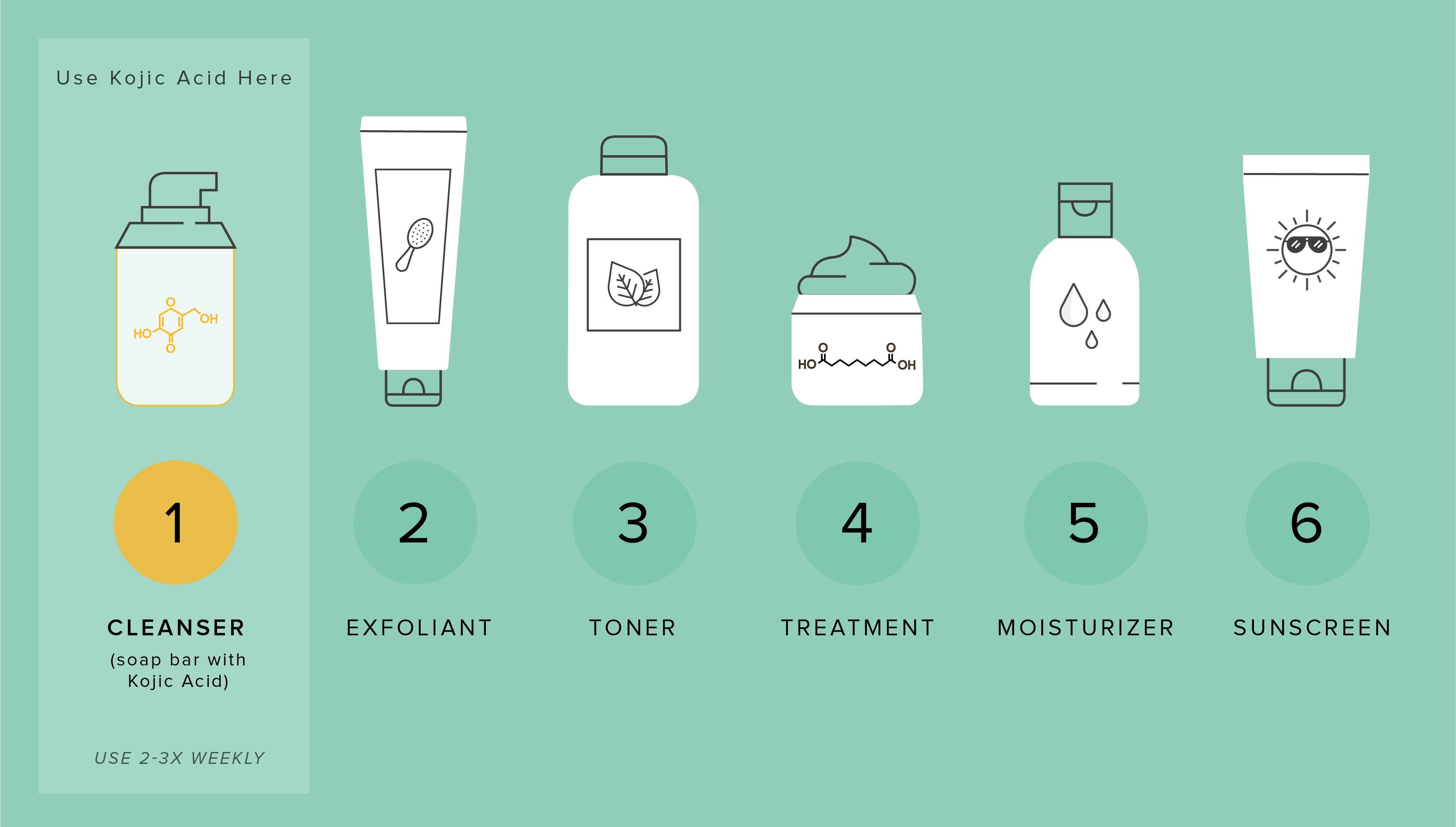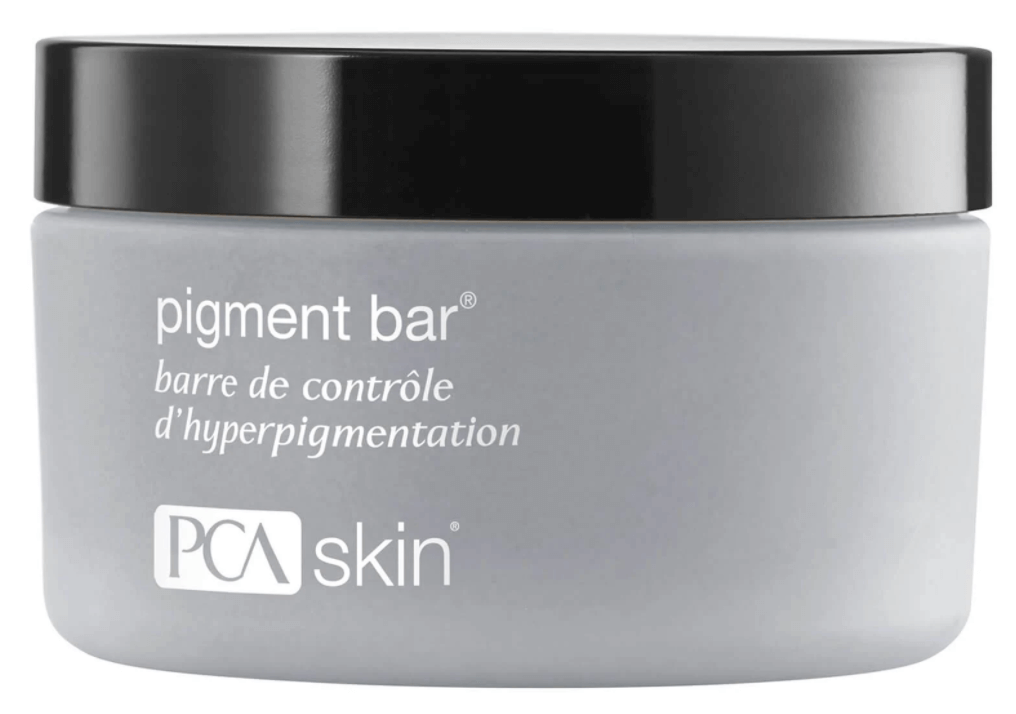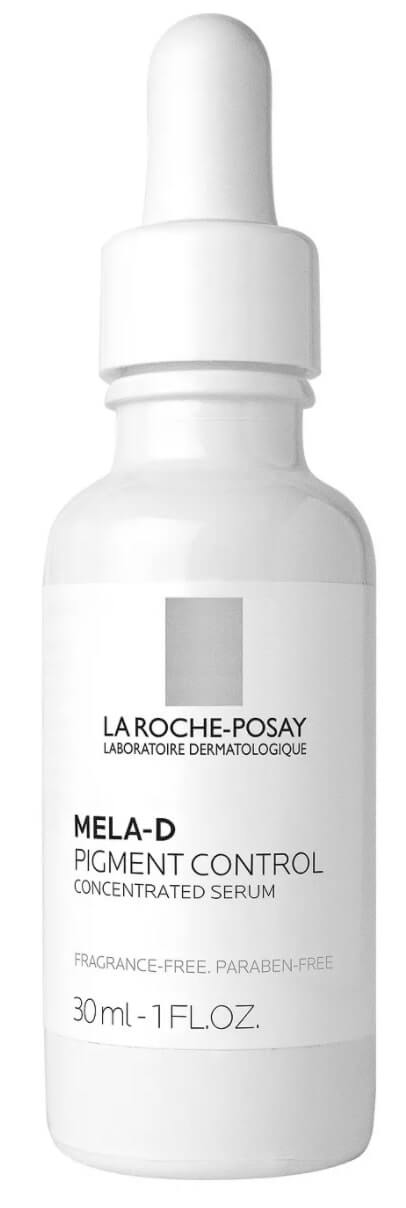Kojic Acid Skin Care Benefits:
All You Need to Know
Kojic acid is derived from several different types of fungi or through the fermentation process of Japanese rice wine (also known as sake). Kojic acid is widely used by dermatologists as a powerful topical skin lightening agent for treating hyperpigmentation (sun spots, age spots, and dark spots) and melasma. It is categorized as a plant extract and tyrosinase inhibitor (a fancy word for a skin lightening agent).
Fun Fact: Kojic acid was discovered in Japan in 1907 when the “new” compound was isolated from a fungus called aspergillus oryzae (also known as kōji mold) -- aspergillus oryzae is used in Japanese food production to saccharify steamed rice, sweet potato, and barley in the making of alcoholic beverages, and also to ferment soybeans for making soy sauce and miso.
Kojic Acid
INGREDIENT CATEGORY: Plant Extract, Tyrosinase Inhibitor
BEST FOR TREATING: Hyperpigmentation (Dark Spots), Melasma, Brightening
SKIN TYPES FOR USE: All
SAFETY: Kojic acid is safe for topical use in concentrations of up to 1% in skin care products. Do not use longer than 3 months at a time.
GHS TIP: Although some people may see results after a few weeks, on average it will take 1-2 months of consistent topical use of kojic acid before you begin to see improvements.
Top 3 Kojic Acid Skin Care Benefits
✓ Natural Skin Lightening Agent
TREATS HYPERPIGMENTATION
Your skin color comes from a pigment called melanin, which is produced when melanocytes convert the enzyme tyrosine into melanin. Problems with melanin occur when ultraviolet (UV) light from years of sun exposure speeds up the production of melanin, causing the melanin to become clumped and produced in high concentrations. This leads to sun spots, age spots, and dark spots.
Kojic acid is used in skin-lightening products because of its ability to inhibit tyrosinase activity (the pigment producing enzyme) in the production of melanin in the skin. As a result, kojic acid fades non-normal pigmentation such as sun spots, age spots, dark spots, and prevents the formation of freckles and skin pigmentation after sunburn.
✓ Brightens Complexion
GET THE JLO GLOW
By fading non-normal pigmentation in your skin, kojic acid brightens your complexion and evens out your skin tone, causing your dull skin to look healthier and more vibrant.
✓ Less Aggressive than Hydroquinone
SAFE & STILL POWERFUL
Kojic acid is a natural ingredient, making it a safe skin lightening agent. Hydroquinone also occurs naturally, however, the synthetic version is the one commonly used in cosmetics, making it a more aggressive skin lightening agent. In addition, if you use hydroquinone incorrectly or for a prolonged period of time, it can cause permanent damage to the skin by causing the skin to turn a bluish/grey color. The FDA has introduced kojic acid as a great alternative for hydroquinone.
When to Use Kojic Acid
SKIN CARE ROUTINE OPTION:
A serum, cream, or gel with kojic acid - use 2x a day

SKIN CARE ROUTINE OPTION B:
A soap bar with kojic acid - use 2-3x times weekly

How to Apply Kojic Acid
Work up to it
Always do a patch test! Start by applying the kojic acid product in the evening to a small area on your forehead (where your facial skin is thickest). If there’s no irritation within 24hrs, begin applying the product as spot treatment to your skin every night. If there’s no irritation after a week and you want to get more aggressive with the treatment, begin applying the kojic acid product both morning and night.
If your skin is super sensitive, when introducing a new kojic acid to your skin, begin using your new kojic acid just once or twice per week to ensure that your skin can tolerate the ingredient. In addition, for those with sensitive skin it is recommended to only use kojic acid in concentrations of 1% or less to avoid irritation.

Apply to entire face or as spot treatment
You can apply kojic acid directly to the areas on your face affected by hyperpigmentation as spot treatment, or you can apply your kojic acid product to your entire face (avoid eyes, lips, and mouth). Besides your face, your chest and hands are other areas that hyperpigmentation can affect as well. Therefore, you can also apply kojic acid to the tops of your hands and chest.

Follow Up With...
Don’t forget to hydrate your skin twice a day with a moisturizer! Let your kojic acid cream or serum fully dry before applying your moisturizer. If you apply moisturizer right away, it will limit your skin’s ability to fully absorb the kojic acid.
Kojic acid can make your skin more susceptible to sunburn and more sensitive to UV rays. Melanin helps protect your skin from sunburn, and since kojic acid limits melanin production, it leaves your skin more vulnerable to sunburn. In addition, if your skin is not protected, UV rays can further damage your skin, causing more hyperpigmentation, and we know you don’t want that. Make sure to limit your time in the sun and apply sunscreen daily.
Kojic Acid in Products


Brightening
Hyperpigmentation
Melasma


All Skin Types!


Chemical Peels
Creams/Gels
Soap Bars
Serums
Masks


Over the Counter
Prescribed Medication
Top 3 Kojic Acid Skin Care Products
We’ve put together a GHS curated selection of our favorite skin care products that contain kojic acid for skin brightening and treating hyperpigmentation. All the products we’ve chosen are sulfate-free and phthalate-free. Remember - results won’t happen overnight. It will take 1-2 months of consistent topical use before you begin to see improvements, so stay consistent with your product usage.
Use 2-3x weekly
Moisten enclosed sponge and work up a creamy lather. Cleanse affected area, allowing lather to remain on skin approximately 2 minutes. Rinse with warm water and pat dry. Can be used in both the morning and the evening.
Price $$
Certified: paraben-free, sulfate-free, phthalate-free, cruelty-free
Use in AM & PM
After cleansing, exfoliating, toning, and vitamin C serum, apply 3 to 5 drops of this serum to your face or any other affected areas. Do not use this product within 24 hours of using a retinol formula.
Price $$
Certified: paraben-free, sulfate-free, phthalate-free
Use in AM & PM
After cleansing, exfoliating, toning, and vitamin C serum, apply 3 to 5 drops of this serum to your face or any other affected areas. Do not use this product within 24 hours of using a retinol formula.
Price $$
Certified: paraben-free, sulfate-free, phthalate-free, cruelty-free, vegan, gluten-free
GHS Tips
Consistency is key
Results won’t happen overnight. Consistency is key. It will take 1-2 months of consistent topical use before you begin to see improvements for the lightening of age spots/sun spots, dark spots, or the treatment of melasma. Be patient - if you don’t see improvement after 90 days, then we recommend trying another kojic acid product or another skin lightening agent ingredient like arbutin.

Close the cap with use
Kojic acid oxidizes on contact with air or light, and when this happens, it turns brown and loses its efficacy (meaning they won’t work anymore). Remember to always put the cap back after each use. If you forget and your kojic acid product is exposed to air for an extended period of time, the hyperpigmentation fighting capabilities of the kojic acid will be ruined.

Serums and creams are more effective
Make sure to use a kojic acid serum, gel, or cream to fight hyperpigmentation head-on. Kojic acid in a soap bar won’t be as effective as quickly for fighting hyperpigmentation on your face because you rinse it off after you put it on. Since kojic acid serums, gels, and creams are more powerful, they make your skin more sensitive to the sun. Make sure to apply sunscreen in the morning.

Pair with glycolic acid for faster results
Glycolic acid has been proven to help aid kojic acid in treating hyperpigmentation and melasma. As the strongest AHA and chemical exfoliant, glycolic acid’s small molecule size has the ability to penetrate the surface of your skin deeper than other AHAs with larger molecule sizes (like lactic acid), and remove pigmented dead skin cells deep within your pores. This helps kojic acid penetrate deeper so results can be reached faster. Therefore, you may see greater results — or faster results — if you also add glycolic acid to the treatment. A lot of skin lightening serums, creams, and lotions that use kojic acid as one of their ingredients also use glycolic acid.

Tingling is normal
Slight tingling and/or redness can be experienced when applying kojic acid - this is normal. However, this is not an indicator of effectiveness - more tingle does not equal better. Use your best judgment. If you feel slight discomfort, don't worry about it, but if you feel like your face is on fire, then rinse it off.

Safety Tips
Kojic acid is Cosmetic Ingredient Review Approved and is safe for topical use in concentrations of up to 1% in skin care products. Learn more about kojic acid's ingredient safety rating on Environmental Working Group (EWG).
SIDE EFFECTS OF KOJIC ACID SKIN CARE PRODUCTS:
- redness or irritation
- dryness, itching, or burning
- in rare cases rashes or swollen skin
IS KOJIC ACID SAFE TO USE DURING PREGNANCY?
- Yes, kojic acid is a safe skin lightening agent for topical use during pregnancy.
✓ Wear sunscreen!
✓ Close the cap with use
✓ Consider consulting a dermatologist - let them determine the right kojic acid concentration for you
X Don't use more than 3 months at a time - you'll damage your skin. Think of it like this: you don't juice cleanse 100% of the year because obviously that would be damaging to your body
X Don't use kojic acid on damaged or broken skin
FAQs about Kojic Acid
Q. What is kojic acid?
Kojic acid is derived from a mushroom-like fungus produced during fermentation or through the fermentation process of Japanese rice wine (also known as sake). It inhibits tyrosinase activity (the pigment producing enzyme) in the production of melanin, making it a widely used topical skin lightening agent for treating hyperpigmentation (sun spots, age spots, and dark spots) and melasma.
 Q. What is kojic acid used for in skin care?
Q. What is kojic acid used for in skin care?Kojic acid is used to treat the following skin concerns:
- Hyperpigmentation (Dark Spots)
- Melasma
- Brightening
 Q. How does kojic acid benefit my skin?
Q. How does kojic acid benefit my skin?The top 4 kojic acid skin benefits are:
- Natural skin lightening agent - inhibits the production of melanin in the skin
- Fades hyperpigmentation
- Brightens your overall complexion
- Less aggressive than hydroquinone
 Q. What skin types is kojic acid good for?
Q. What skin types is kojic acid good for?Kojic acid is safe to use on all skin types.
 Q. Is kojic acid safe for my skin?
Q. Is kojic acid safe for my skin?Kojic acid is safe for topical use in concentrations of up to 1% in skin care products.
 Q. Is kojic acid a safe ingredient to use during pregnancy?
Q. Is kojic acid a safe ingredient to use during pregnancy?Yes, kojic acid is a safe skin care ingredient to use during pregnancy.
 Q. What are common side effects from applying kojic acid topically?
Q. What are common side effects from applying kojic acid topically?Commone side effects from applying kojic acid topically include redness or irritation, itchiness or burning, and in rare cases can cause rashes or swollen skin. Always be sure to do a patch test on a thicker part of your skin (square inch on your arm or forehead) before applying a new product to your entire face.
 Q. How long does kojic acid take to work topically?
Q. How long does kojic acid take to work topically?Results will not happen overnight. Although some people may see results after a few weeks, on average it will take 1-2 months of consistent topical use of kojic acid before you begin to see improvements. Remember - consistency is key for optimal results.
 Q. Is kojic acid safe to use everyday?
Q. Is kojic acid safe to use everyday?Yes, kojic acid is safe to use everyday. Depending on your skin's sensitivity, it can be used twice a day. Just remember, don't use kojic acid more than 3 months at a time because that can be damaging to your skin.
 Q. Is kojic acid a bleaching agent?
Q. Is kojic acid a bleaching agent?Yes, but it is less aggressive than hydroquinone. Kojic acid is considered a bleaching agent because of its ability to to lighten skin by inhibiting melanin production.
 Q. Can kojic acid permanently lighten or bleach skin?
Q. Can kojic acid permanently lighten or bleach skin?No, kojic acid does not have the ability to permanently bleach or lighten your skin. Although kojic acid can lighten and brighten your skin, it is not destroying the melanin - kojic acid is only disrupting the production of melanin. So if you use kojic acid and feel like your skin is becoming too light, you can hit the ‘undo’ button by stopping arbutin application and the melanin production in your skin will speed up again. The lightened skin and brightness achieved from kojic acid products will not immediately reverse as soon as you stop using kojic acid skincare, instead it will take many months to return to its previous state. In order to permanently lighten your skin, you would need to use an ingredient like monobenzylether, which completely destroys and removes melanin cells from your skin, causing your skin to become very pale no matter the skin color you started with. We do not recommend monobenzylether for your skin because it can be damaging to your skin.
Note: If your skin darkening has been caused by temporary skin damage (i.e. from acne), then in this case, kojic acid may have the ability to permanently lighten the darker colored skin (i.e. acne scars).
 Q. Is kojic acid safe for dark skin?
Q. Is kojic acid safe for dark skin?Yes, kojic acid is safe for both dark skin and light skin - it has been formulated for all skin tones. Kojic acid cannot change the color of your naturally dark skin, it can only lighten non-normal pigmentation caused from freckles, age spots, sun spots, acne scars, or melasma. Keep in mind that darker skin types have more natural melanin, so it may take longer to see results.
 Q. Can kojic acid lighten pregnancy melasma?
Q. Can kojic acid lighten pregnancy melasma?Yes, kojic acid has the ability to lighten pregnancy melasma. Pregnant women often suffer from dark spots called melasma since pregnancy hormones can push melanin production into overdrive. Many skin lighteners contain toxic ingredients like hydroquinone, so that's why kojic acid - a naturally occurring ingredient - is a great alternative.
 Q. Do kojic acid skin care products expire?
Q. Do kojic acid skin care products expire?Yes. Look for either an expiration date or a POA (prescribed period after opening). A POA tells you how long the product is good for after opening. If your kojic acid product has expired, do not use it - expired products can cause skin irritation, bacterial infection, or breakouts.
 Q. What are common names used to identify kojic acid on an ingredient list for skin care products?
Q. What are common names used to identify kojic acid on an ingredient list for skin care products?- Kojic Acid
- KA
 Q. What professinal skin care brand products contain kojic acid?
Q. What professinal skin care brand products contain kojic acid?
- AEC Kojic Acid
- Kojic Acid SL
- Kojissan TQ
- Melanobleach-K
- OriStar KA
- ROTA KA

Want More GHS Tips?
It’ll be the best thing to ever slide into your DM's.


